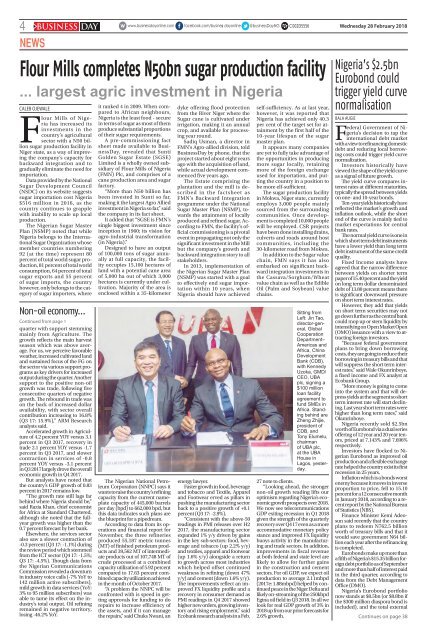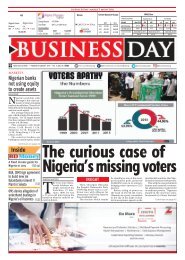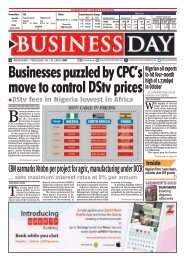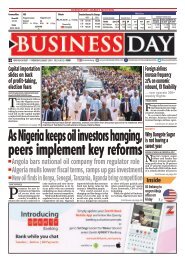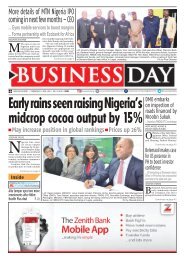BusinessDay 28 Feb 2018
Create successful ePaper yourself
Turn your PDF publications into a flip-book with our unique Google optimized e-Paper software.
4 BUSINESS DAY<br />
C002D5556<br />
Wednesday <strong>28</strong> <strong>Feb</strong>ruary <strong>2018</strong><br />
NEWS<br />
Flour Mills completes N50bn sugar production facility<br />
... largest agric investment in Nigeria<br />
CALEB OJEWALE<br />
Flour Mills of Nigeria<br />
has increased its<br />
investments in the<br />
country’s agricultural<br />
sector with a N50 billion<br />
sugar production facility in<br />
Niger state, as a way of improving<br />
the company’s capacity for<br />
backward integration and to<br />
gradually eliminate the need for<br />
importation.<br />
Data provided by the National<br />
Sugar Development Council<br />
(NSDC) on its website suggests<br />
sugar importation cost Nigeria<br />
$516 million in 2016, as the<br />
country continues to grapple<br />
with inability to scale up local<br />
production.<br />
The Nigerian Sugar Master<br />
Plan (NSMP) noted that while<br />
Nigeria belongs to the International<br />
Sugar Organization whose<br />
member countries numbering<br />
92 (at the time) represent 80<br />
percent of total world sugar production,<br />
81 percent of total world<br />
consumption, 64 percent of total<br />
sugar exports and 55 percent<br />
of sugar imports, the country<br />
however, only belongs to the category<br />
of sugar importers, where<br />
Non-oil economy...<br />
Continued from page 1<br />
quarter with support stemming<br />
mainly from Agriculture. The<br />
growth reflects the main harvest<br />
season which was above average.<br />
For us, we perceive favorable<br />
weather, increased cultivated land<br />
and sustained focus of the FG on<br />
the sector via various support programs<br />
as key drivers for increased<br />
output during the quarter. Another<br />
support to the positive non-oil<br />
growth was trade, following five<br />
consecutive quarters of negative<br />
growth. The rebound in trade was<br />
on the back of increased dollar<br />
availability, with sector overall<br />
contribution increasing to 16.8%<br />
(Q3 17: 15.9%),” ARM Research<br />
analysts said.<br />
Accelerated growth in Agriculture<br />
of 4.2 percent YOY versus 3.1<br />
percent in Q3 2017, recovery in<br />
trade 2.1 percent YOY versus -1.7<br />
percent in Q3 2017, and slower<br />
contraction in services of -0.8<br />
percent YOY versus -3.1 percent<br />
in Q3 2017 largely drove the overall<br />
economic growth in Q4 2017.<br />
But analysts have noted that<br />
the country’s GDP growth of 0.83<br />
percent in 2017 remains low.<br />
“The growth rate still lags far<br />
behind where Nigeria should be,”<br />
said Razia Khan, chief economist<br />
for Africa at Standard Chartered,<br />
although she noted that the fullyear<br />
growth was higher than the<br />
0.7 percent forecast by her bank.<br />
Elsewhere, the services sector<br />
also saw a slower contraction of<br />
-0.3 percent (Q3 17: -1.1%) during<br />
the review period which stemmed<br />
from the ICT sector (Q4 17: -1.5%;<br />
Q3 17: -4.5%). Though data from<br />
the Nigerian Communications<br />
Commission revealed a downturn<br />
in industry voice calls (-7% YoY to<br />
142 million active subscribers),<br />
mild growth in data services (YoY:<br />
3% to 95 million subscribers) was<br />
able to tame its effect on the industry’s<br />
total output. Oil refining<br />
remained in negative territory,<br />
losing -46.2% YoY.<br />
it ranked 4 in 2009. When compared<br />
to African neighbours,<br />
Nigeria is the least food - secure<br />
in terms of sugar as most of them<br />
produce substantial proportions<br />
of their sugar requirements.<br />
A pre-commissioning fact<br />
sheet made available to <strong>BusinessDay</strong>,<br />
revealed that Sunti<br />
Golden Sugar Estate (SGSE)<br />
Limited is a wholly owned subsidiary<br />
of Flour Mills of Nigeria<br />
(FMN) Plc, and comprises of a<br />
cane production area and sugar<br />
factory.<br />
“More than N50 billion has<br />
been invested in Sunti so far,<br />
making it the largest Agro Allied<br />
investment in Nigeria so far,” said<br />
the company in its fact sheet.<br />
It added that “SGSE is FMN’s<br />
single biggest investment since<br />
inception in 1960; its vision for<br />
agro-industrial transformation<br />
(in Nigeria).”<br />
Designed to have an output<br />
of 100,000 tons of sugar annually<br />
at full capacity, the facility<br />
occupies 15,100 hectares of<br />
land with a potential cane area<br />
of 5,000 ha out of which 3,000<br />
hectares is currently under cultivation.<br />
Majority of the area is<br />
enclosed within a 35-kilometer<br />
The Nigerian National Petroleum<br />
Corporation (NNPC) says it<br />
wants to raise the country’s refining<br />
capacity from the current nameplate<br />
capacity of 445,000 barrels<br />
per day (bpd) to 662,000 bpd, but<br />
this data indicates such plans are<br />
the blueprint for a pipedream.<br />
According to data from its operations<br />
and financial report for<br />
November, the three refineries<br />
produced 55,187 metric tonnes<br />
(MT) of finished petroleum products<br />
and 39,562 MT of intermediate<br />
products out of 107,748 MT of<br />
crude processed at a combined<br />
capacity utilization of 5.92 percent<br />
compared to 17.63 percent combined<br />
capacity utilization achieved<br />
in the month of October 2017.<br />
“A problem the NNPC will be<br />
confronted with is speed in getting<br />
approvals for funding to do<br />
repairs to increase efficiency of<br />
the assets, and if it can manage<br />
the repairs,” said Chuks Nwani, an<br />
dyke offering flood protection<br />
from the River Niger where the<br />
Sugar cane is cultivated under<br />
irrigation, making it an annual<br />
crop, and available for processing<br />
year round.<br />
Sadiq Usman, a director in<br />
FMN’s Agro-allied division, told<br />
<strong>BusinessDay</strong> by phone, that the<br />
project started about eight years<br />
ago with the acquisition of land,<br />
while actual development commenced<br />
five years ago.<br />
The Estate comprising the<br />
plantation and the mill is described<br />
in the factsheet as<br />
FMN’s Backward Integration<br />
programme under the National<br />
Sugar Master Plan (NSMP), towards<br />
the attainment of locally<br />
produced and refined sugar. According<br />
to FMN, the facility’s official<br />
commissioning is a pivotal<br />
event in propagating not only the<br />
significant investment in the Mill<br />
but the company’s growth and<br />
backward integration story to all<br />
stakeholders.<br />
In 2013, implementation of<br />
the Nigerian Sugar Master Plan<br />
(NSMP) was started with a goal<br />
to effectively end sugar importation<br />
within 10 years, when<br />
Nigeria should have achieved<br />
energy lawyer.<br />
Faster growth in food, beverage<br />
and tobacco and Textile, Apparel<br />
and Footwear erved as pillars in<br />
pushing the manufacturing sector<br />
back to a positive growth of +0.1<br />
percent (Q3 17: -2.9%).<br />
“Consistent with the above-50<br />
readings in PMI releases over H2<br />
2017, the manufacturing sector<br />
expanded 1% y/y driven by gains<br />
in the key sub-sectors: food, beverage<br />
and tobacco (up 2.2% y/y)<br />
and textiles, apparel and footwear<br />
(up 1.6% y/y) alongside a return<br />
to growth across most industries<br />
which helped offset continued<br />
weakness in refining (down 47%<br />
y/y) and cement (down 1.6% y/y).<br />
The improvements reflect an improved<br />
FX liquidity profile and a<br />
recovery in consumer demand as<br />
PMI readings in Q4 2017 showed<br />
higher new orders, growing inventory<br />
and rising employment,” said<br />
Ecobank research analysts in a <strong>Feb</strong>.<br />
self-sufficiency. As at last year,<br />
however, it was reported that<br />
Nigeria has achieved only 40.3<br />
per cent of the target set for attainment<br />
by the first half of the<br />
10-year lifespan of the sugar<br />
master plan.<br />
It appears many companies<br />
are yet to fully take advantage of<br />
the opportunities in producing<br />
more sugar locally, retaining<br />
more of the foreign exchange<br />
used for importation, and putting<br />
the country in a position to<br />
be more elf-sufficient.<br />
The sugar production facility<br />
in Mokwa, Niger state, currently<br />
employs 3,000 people mainly<br />
sourced from the surrounding<br />
communities. Once development<br />
is completed 10,000 people<br />
will be employed. CSR projects<br />
have been done installing drains,<br />
culverts and roads around host<br />
communities, including the<br />
30-kilometer road from Mokwa.<br />
In addition to the Sugar value<br />
chain, FMN says it has also<br />
embarked on significant backward<br />
integration investments in<br />
the Cassava/Sorghum/Wheat<br />
value chain as well as the Edible<br />
Oil (Palm and Soybean) value<br />
chains.<br />
Sitting from<br />
Left: Jin Tao,<br />
director-general,<br />
Global<br />
Cooperation<br />
Department–<br />
Americas and<br />
Africa, China<br />
Development<br />
Bank (CDB),<br />
with Kennedy<br />
Uzoka, GMD/<br />
CEO, UBA<br />
plc, signing a<br />
$100 million<br />
loan facility<br />
agreement to<br />
fund SMEs in<br />
Africa. Standing<br />
behind are<br />
Zheng Zhijie,<br />
president of<br />
CDB, and<br />
Tony Elumelu,<br />
chairman<br />
of UBA plc,<br />
at the UBA<br />
House in<br />
Lagos, yesterday.<br />
27 note to clients.<br />
“Looking ahead, the stronger<br />
non-oil growth reading lifts our<br />
optimism regarding Nigeria’s economic<br />
growth prospects over <strong>2018</strong>.<br />
We now see telecommunications<br />
GDP exiting recession in Q1 <strong>2018</strong><br />
given the strength of the quarterly<br />
recovery over Q4 17 even as a more<br />
accommodative monetary policy<br />
stance and improved FX liquidity<br />
buoys activity in the manufacturing<br />
and trade sectors. In addition,<br />
improvements in fiscal revenue<br />
at both federal and state level are<br />
likely to allow for further gains<br />
in the construction and cement<br />
sectors. For oil GDP, we expect oil<br />
production to average 2.11mbpd<br />
(2017e: 1.88mbpd) helped by continued<br />
peace in the Niger Delta and<br />
likely on-streaming of the 250kbpd<br />
Egina oil field in Q3 <strong>2018</strong>. In all we<br />
look for real GDP growth of 3% in<br />
<strong>2018</strong> up from our prior forecasts for<br />
2.6% growth.<br />
Nigeria’s $2.5bn<br />
Eurobond could<br />
trigger yield curve<br />
normalisation<br />
BALA AUGIE<br />
Federal Government of Nigeria’s<br />
decision to tap the<br />
international debt market<br />
with a view to refinancing domestic<br />
debt and reducing local borrowing<br />
costs could trigger yield curve<br />
normalization.<br />
Investors historically have<br />
viewed the shape of the yield curve<br />
as a signal of future growth.<br />
The yield curve compares interest<br />
rates at different maturities,<br />
typically the spread between yields<br />
on one- and 10-year bonds.<br />
Ten-year yields historically have<br />
reflected the market’s growth and<br />
inflation outlook, while the short<br />
end of the curve is mainly tied to<br />
market expectations for central<br />
bank rates.<br />
The normal yield curve is one in<br />
which short term debt instruments<br />
have a lower yield than long term<br />
debt instrument of the same credit<br />
quality.<br />
Fixed Income analysts have<br />
agreed that the narrow difference<br />
between yields on shorter term<br />
paper of 15.40 percent and the yield<br />
on long term dollar denominated<br />
debt of 13.80 percent means there<br />
is significant downward pressure<br />
on short term interest rates.<br />
However, they add that yields<br />
on short term securities may not<br />
go down further as the central bank<br />
could mop up or stem liquidity by<br />
intensifying on Open Market Open<br />
(OMO) issuance with a view to attracting<br />
foreign investors.<br />
“Because federal government<br />
plans to bring down borrowing<br />
costs, they are going to reduce their<br />
borrowing in treasury bills and that<br />
will suppress the short term interest<br />
rates,” said Wale Okunrinboye,<br />
a fixed income and FX analyst at<br />
Ecobank Group.<br />
“More money is going to come<br />
into the system and that will depress<br />
yields at the segment so short<br />
term interest rate will start declining.<br />
Last year short term rates were<br />
higher than long term rates,” said<br />
Okunrinboye.<br />
Nigeria recently sold $2.5bn<br />
worth of Eurobond via a dual series<br />
offering of 12 year and 20 year tenors,<br />
priced at 7.143% and 7.696%<br />
respectively.<br />
Investors have flocked to Nigerian<br />
Eurobond as improved oil<br />
production and a flexible exchange<br />
rate helped the country exist its first<br />
recession in 25 years.<br />
Inflation which is a bonds worst<br />
enemy because it moves in inverse<br />
proportion to price, fell to 15.10<br />
percent for a 12 consecutive month<br />
in January <strong>2018</strong>, according to a recent<br />
report by the National Bureau<br />
of Statistics (NBS).<br />
Finance Minister Kemi Adeosun<br />
said recently that the country<br />
plans to redeem N762.5 billion<br />
worth of treasury bills and that it<br />
would save government N64 billion<br />
each year after the refinancing<br />
is completed.<br />
Eurobonds make up more than<br />
a fifth of Nigeria’s $15.35 billion foreign<br />
debt portfolio as of September<br />
and more than half of interest paid<br />
in the third quarter, according to<br />
data from the Debt Management<br />
Office (DMO).<br />
Nigeria’s Eurobond portfolio<br />
now stands at $8.5bn (or $8.8bn if<br />
the $300 million diaspora bond is<br />
included), and the total external<br />
Continues on page 38


